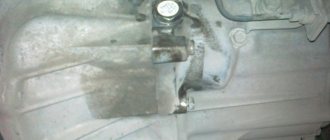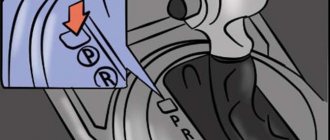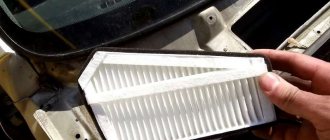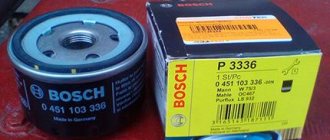Basic properties and characteristics of technical oils in the machine
The manufacturer constantly tests lubricants in order to determine the oil most suitable for use in an automatic transmission. At the same time, the optimal timing for replacing the lubricant is also established.
The functions of an automatic transmission include transferring the power of the power unit to the wheels of the car to overcome a certain section of the road. In this case, part of the engine energy and the volume of transmission oil is spent on reducing internal friction between the working parts and automatic transmission components.
If low-quality lubricants are used, the oil quickly heats up, oxidizes, and corrosion of automatic transmission elements and the entire vehicle occurs.
High-quality lubricating fluids for cars with automatic transmission actively resist oxidative processes and prevent the appearance of corrosion spots inside the automatic transmission.
Transmission oils can withstand high temperature changes and do not boil, creating the necessary coefficient of performance (COP) of the vehicle transmission.
Do I need to check the quality of the liquid in the box and how often should this be done?
Experts say: once a week. If the liquid has become dark and has a burnt smell, then there is no need to wait for a scheduled replacement. It is checked on a paper napkin. You need to drop a drop from the dipstick onto a napkin and make sure that there are no foreign inclusions in the drop; the liquid should be easily absorbed, transparent and homogeneous.
In this case, the crankcase is not flushed. The debris must be removed manually, and the magnet on which the shavings have collected is cleaned. After assembling the unit, new oil is poured in, despite the fact that the replacement was made recently. It is also necessary to check the engine cooling system: the antifreeze must be transparent, without containing a water-oil emulsion. And replacing the gearbox lubricant entails changing the filter and pan gasket.
You must remember: the machine cannot be operated with a faulty gearbox. It is necessary to promptly diagnose the unit and change the oil. Then the life of the car will be extended.
Kolodiychuk Andrey
, especially for
How to check the oil in an automatic transmission
While operating the vehicle, it is recommended to regularly check the amount of lubricant. This can be done with or without a special probe.
Before checking the transmission oil, the automatic transmission is heated to 650 C. To do this, you will need to drive the car 10-15 kilometers. Or, turning on the power unit, standing still, wait for the fan to start working. In this case, the coolant temperature reaches 90-950 C. The vehicle’s automatic transmission shift lever is placed in the neutral position, and the parking brake is engaged. The lubricant level is checked with the power unit running.
Methods for replacing ATF in automatic transmissions
Needless to say, each manufacturer of automatic transmissions determines the frequency of lubricant changes for their gearbox independently. This range ranges from 30 thousand to 125 thousand km. Precise information about the frequency of replacement is contained inside the service books that come with each car.
Modern electronic control systems are able to remember failures and errors in the operation of automatic transmissions. Therefore, having specialized equipment, they can be diagnosed. That is, most faults can be determined without removing the box from the car. If no serious problems are identified, you can proceed to replacing the ATF.
The most effective method is to completely replace the old transmission fluid with a new composition. To do this, the used fluid is pumped out, and a new one takes its place. True, this method cannot be applied to all units. For example, for Honda transmissions this method is strictly contraindicated. This is due to the fact that the pallet of their boxes is not removable. In addition, lubricant under pressure will certainly clog the filter. Structurally, it is located inside the box and is non-removable. To get to it, you have to “prick” the gearbox.
For Honda, the best way is a partial replacement after every 30–35 thousand kilometers. You can change the lubricant completely, but to do this you will have to make 3-4 partial changes in a row after every 200-300 kilometers of travel. In many other models, forced replacement is acceptable. After adapting the automatic transmission, the control equipment resets the control unit data.
Partial oil fluid replacement is common as the simplest procedure. The car owner can carry out this work independently if there is an inspection hole or overpass. True, such an operation should be carried out at least 2 times more often than specified in the service book. In this way you can get rid of two problems at once:
- The oil composition is not radically updated. If this happened, the updated detergent additives could clog the hydraulics.
- The lubricating fluid did not change its characteristics dramatically. This means that the operating conditions of the gearbox components and parts do not change much.
From the above, the summary suggests itself: replacing the transmission in an automatic transmission is vital. If you want to keep it without expensive major repairs, change the lubricant every 30–40 thousand kilometers, not paying attention to the “bikes” of the service books.
Checking lubrication without a dipstick
Some cars equipped with automatic transmissions do not have a dipstick. Instead, there are two holes: for filling and draining the working fluid. Cars of this design are designed for service in service centers.
For boxes without a dipstick, a special limiter for the amount of working product is provided in the drain hole. This long tube works on the principle of draining excess into the pan of the car. Consequently, the level is determined by the height of the limiter, which eliminates ATF overflow.
Checking transmission oil is a labor-intensive process. Not everyone will be able to say exactly what quality of lubricant is in the automatic transmission and what quantity is left. Therefore, it is better to entrust the inspection to service station specialists.
The verification process is as follows:
- The automatic transmission warms up to a certain t0 (see instructions above).
- The car is placed over the repair pit.
- The automatic transmission gear shift lever is set to the neutral position.
- The power unit does not turn off.
- The oil pan drain plug is unscrewed.
- When performing the above steps, a small amount of liquid should spill.
If this does not happen, then its quantity is below the required norm.
It is important to regularly check the oil level in order to avoid repairs to the unit and extend the operational life of the automatic transmission.
When do you need to change the transmission oil in an automatic transmission?
The frequency of changing transmission oil depends on the make of the car, the year of manufacture of the vehicle and the design of the automatic transmission.
How often to change automatic transmission oil. The fluid should be changed after traveling 50-60 thousand km under normal operating conditions. If the car mostly works in intensive mode, on poor-quality road surfaces, replacement can be performed more often: after about 30 thousand km.
How to replace machine lubricant
Replacing the lubricant in the automatic transmission can be complete or partial. The latter is done when the car owner simply needs to add fluid so that the machine can “live” another 20 thousand kilometers until it is completely replaced, without global damage to the mechanical parts.
Step-by-step instructions for partial replacement
In order to partially replace the fluid, it is necessary to prepare the following elements:
- a container with measurements to understand how much was drained;
- new lubricant;
- funnel.
Partial replacement proceeds as follows:
- Drive the car onto the overpass.
- Leave the engine running and drive the gearbox through all speeds while pressing the brake pedal.
- Turn off the motor.
- Remove the fluid drain plug on the transmission pan.
- Place the measuring container and wait until the oil has completely drained into it.
- Screw in the drain plug.
- Using the measurements, determine the amount of leaked oil and, inserting a funnel into the filler hole, add the required amount of new lubricant.
- Turn on the engine.
- Drive the automatic transmission through all gears again so that the two types of fluid mix with each other.
You can determine the fluid level using a dipstick. If there is not enough lubricant, add more.
Complete replacement
A car enthusiast can completely change the oil to a new one at a service station if the car owner is not sure that he can handle it himself. The owner of the car must determine how long it takes to completely change the oil, guided by the diagram described above.
Items that will be needed during a complete oil change in an automatic transmission:
- new ATF;
- measuring container;
- rubber gasket;
- sealant;
- partner;
- new filter.
Read
How much oil is needed for a complete and partial change in an automatic transmission?
How the replacement works:
- Drive the car for five kilometers to warm up the machine thoroughly.
- Stand on the overpass.
- Remove the drain plug and place a container under the pan.
- Wait a while until all the oil has drained out.
- Remove the screws from the tray and carefully set it aside. It may contain an additional half liter of dirty oil.
- Clean the pan from soot deposits and metal shavings. Remove the old gasket and install a new one. Wipe the inside of the tray dry with a lint-free cloth.
- Install a new filter.
- Apply silicone to the pan gasket and screw it to the bottom of the car.
- Tighten the plug and pour in new oil. You will need as much of it as was poured into the measuring container.
- Remove one cooling hose, which is located in the direction of travel, and insert it into the prepared five-liter bottle.
- At this time, the partner must put the car on the handbrake and the automatic transmission switch to neutral speed. Start the engine. The old oil, which is pressed through by the newly refilled oil, will be drained into the bottle using a hose. Drain until the oil turns light. This means that something new has happened. This can stop further drainage.
- Add the same amount as drained.
- Re-tighten the car cooling hose.
- Drive the car for five kilometers and check the level. If necessary, top up.
Complete technical oil change.
In this option, it is preferable to contact the service center specialists, since the work will require special equipment. Changing an old product to a new ATF is carried out under a certain pressure. Control is carried out by the color of the transmission oil. When the ATF color at the outlet and inlet becomes the same, the replacement process can be completed.
Prices for complete oil change services are not the same everywhere, but on average they are affordable. In this matter, it is necessary to put the quality of the process first, not the cost of the work.
Maintenance-free automatic machine - myth or truth
Thus, it is a stretch to talk about automatic transmissions that do not require oil changes throughout their entire service life. Any experienced car enthusiast, and even more so a specialist, will confirm that the lubricant (in this case ATF) inevitably loses its characteristics over time. This occurs primarily due to overheating due to intensive use of the car in unfavorable conditions, for example, during constant off-road driving or regular pushing in city traffic jams. But even if the car is used carefully and the oil is not overheated, it still loses its properties with age. Anti-wear and extreme pressure additives are produced, and the quality of the base deteriorates. In addition to this, ATF becomes contaminated with wear products from the box parts. All this means that the oil in the automatic transmission needs to be changed periodically.
What kind of oil to fill in automatic transmission
First of all, you need to decide on the frequency of replacement, and then look at how much oil you need to fill. When purchasing oil, refer to the service book for answers. If the car is purchased second-hand and the book is missing, the manufacturer’s manual is used as a basis. Why reinvent the wheel, the developers provide full information about replacement periods and indicate which oil to use in the automatic transmission.
Manufacturers from the Land of the Rising Sun recommend replacing ATF after 20 thousand km of vehicle mileage. In Europe, technical oil changes are carried out after 40-50, respectively. Many manufacturers recommend homemade oil. The most common are:
- transmission mineral lubricants;
- semi-synthetic products; synthetics;
- universal oils.
Today, many leading manufacturers recommend their own brand Automatic Transmission Fluid:
- Mercedes cars use ATF MERCEDES automatic transmission fluid.
- The German concern BMW recommends ZF brand oil for its cars.
- The Toyota company offers to pour a lubricant into Toyota ATF TOYOTA TYPE cars.
- A separate lubricant mixture has been developed for Lexus - “WS”.
- The VOLKSWAGEN GROUP recommends using its own product for Audi, Skoda and Volkswagen cars: “G-052, G-053 – G-055” or “ZF” brand lubricant, intended for middle-class cars. For cheaper cars, “ESSO” is suitable.
- The Chevrolet company offers to fill cars with Dextron 6 oil. The manufacturer recommends using Mobil DEXRON-VI ATF, ZIC DEXRON-VI for cars with automatic transmission.
- The Nissan concern has developed its own transmission oil “Nissan Matic” for its cars with automatic transmissions Nissan, Infiniti, Datsun.
- KIA and Hyundai did not stand aside and prepared the Hyundai ATF SP-III brand trademark. In addition, for cars with automatic transmission, you can use ZIC ATF SP-III.
Reinstall the filter and add fluid
I advise you to replace the old filter with a new one from the repair kit and clean out the old dirt from the gasket. Many car models use silicone material as plugs, so you may have to scrape it off yourself. Use a razor blade or knife.
Reinstall the new gasket. Personally, I have become accustomed to, and recommend to everyone, the use of multiple bolts to hold the gasket in place while you install the cover. Tighten them, moving from side to side so that the cap is evenly tightened. You can now add automatic transmission fluid.
The owner's manual for the same Ford Focus says it uses 6.6 liters. I was only able to get 4.5 liters out of it. This is because the rest of the oil is still in the low part of your transmission as well as the torque converter.
Be careful not to overfill the container. Top it up to about halfway up the dipstick and then go for a 10-minute drive. Go back and check the mixture level again once the oil is warm.
Always check the transmission level while the vehicle is running. If you need a key to open the hood (it's usually under the logo), you'll have to use a spare key.











